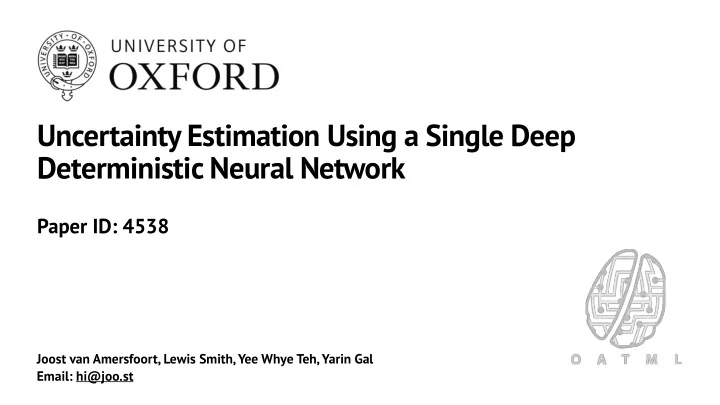

Uncertainty Estimation Using a Single Deep Deterministic Neural Network Paper ID: 4538 Joost van Amersfoort, Lewis Smith, Yee Whye Teh, Yarin Gal Email: hi@joo.st
DUQ - 4 min Overview
Why do we want uncertainty? Many applications need uncertainty • Self-driving cars • Active Learning • Exploration in RL
Deterministic Uncertainty Quantification (DUQ) • A robust and powerful method to obtain uncertainty in deep learning • Match or outperform Deep Ensembles uncertainty with the runtime cost of a single network • Does not extrapolate arbitrarily and is able to detect OoD data
Two Moons Certain Uncertain Deep Ensembles 1 DUQ (1) Lakshminarayanan, Balaji, Alexander Pritzel, and Charles Blundell. "Simple and scalable predictive uncertainty estimation using deep ensembles." Advances in neural information processing systems . 2017.
The Model Cat Prediction e 1 • Uncertainty = distance between feature 1 n || W c f θ ( x ) − e c || 2 f θ } 2 Uncertainty representation and closest centroid = exp − 2 σ 2 f θ ( x ) • Deterministic, cheap to calculate e 2 Dog • Old idea based on RBF networks e 3 Bird Centroids
Overview • Use “One vs Rest” loss function to update model f θ ( x ) • Update centroids with exponential moving average Standard RBF • Regularise centroids to stay close to origin • Need to be well behaved → f θ ( x ) penalty on the Jacobian DUQ
Results • Training is easy and stable • Accuracy same as common softmax networks • Match or outperform Deep Ensembles uncertainty with the runtime cost of a single network Train on FashionMNIST Evaluate on FashionMNIST + MNIST
DUQ - Deep(er) Dive
Uncertainty Estimation Cat Prediction e 1 1 n || W c f θ ( x ) − e c || 2 f θ } 2 Uncertainty = exp − 2 σ 2 f θ ( x ) e 2 Dog • Uncertainty estimation for classification e 3 Bird • Use a deep neural network for feature extraction Centroids • Single centroid per class • Define uncertainty as distance to closest centroid in feature space
Uncertainty Estimation Cat Prediction e 1 1 n || W c f θ ( x ) − e c || 2 f θ } 2 Uncertainty = exp − 2 σ 2 f θ ( x ) e 2 Dog • Uncertainty estimation for classification e 3 Bird • Use a deep neural network for feature extraction Centroids • Single centroid per class • Define uncertainty as distance to closest centroid in feature space • Deterministic and single forward pass!
DUQ - Overview • Use “One vs Rest” loss function to update model f θ ( x ) • Update centroids with exponential moving average Standard RBF • Regularise centroids to stay close to origin • Need to be well behaved → f θ ( x ) penalty on the Jacobian DUQ
Learning the Model • “One vs Rest” loss function • Decrease distance to correct centroid, while increasing it relative to all others • Avoids centroids collapsing on top of each other • Regularisation avoids centroids exploding
Learning the Centroids Gradient Centroid • Exponential distance from centroid is bad for gradient based learning • When far away from the correct centroid, the gradient goes to zero • No learning signal for model Data
Learning the Centroids • Move each centroid to the mean of the feature vector of that class Centroid moves towards the data • Use exponential moving average with heavy momentum to make this work with mini-batches. Set to 0.99(9)
DUQ - Overview • Use “One vs Rest” loss function to update model f θ ( x ) • Update centroids with exponential moving average Standard RBF • Regularise centroids to stay close to origin • Need to be well behaved → f θ ( x ) penalty on the Jacobian DUQ
Why do we need to regularise ƒ? • Classification is at odds with being able to detect OoD input • Is the black star OoD? • Classification means we ignore features that don’t affect the class
Stability & Sensitivity • Two-sided gradient penalty λ ⋅ [ || ∇ x ∑ 2 • From above : low Lipschitz constant - 2 − L ] commonly used K c || 2 • From below: sensitive to changes in c the input ||ƒ(x) - ƒ(x + δ )|| > L
Stability & Sensitivity • Two-sided gradient penalty • From above : low Lipschitz constant - commonly used DUQ - penalty from above • From below: sensitive to changes in the input ||ƒ(x) - ƒ(x + δ )|| > L DUQ - two sided penalty
Results • FashionMNIST vs MNIST Out of Distribution detection • Rejection Classification on CIFAR-10 (training set) and SVHN (out of distribution set)
Summary • A robust and powerful method to obtain uncertainty in deep learning • Match or outperform Deep Ensembles 1 uncertainty with the runtime cost of a single network • No arbitrary extrapolation and able to detect OoD data
Limitations and Future Work • Aleatoric Uncertainty. DUQ is not able to estimate this. The one class per centroid system makes training stable, but does not allow assigning a data point to multiple classes. • Probabilistic Framework. DUQ is not placed in a probabilistic framework, however there are interesting similarities to inducing point GPs with parametrised (“deep”) kernels
Come chat with us Time slots available on ICML website - Missed us? Email at hi@joo.st Joost van Amersfoort Lewis Smith Yee Whye Teh Yarin Gal
Recommend
More recommend